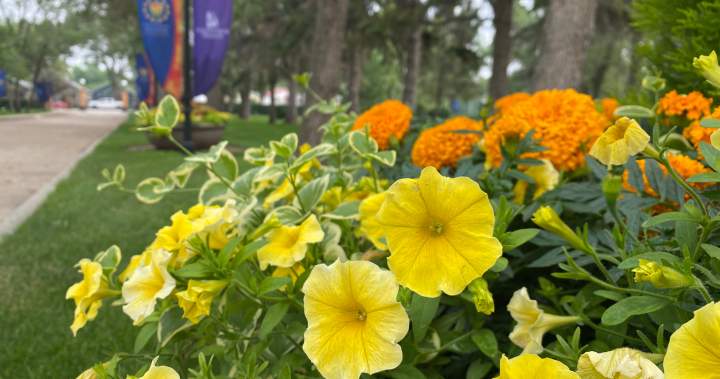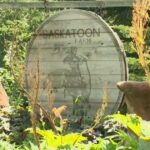There’s something almost transcendent about walking through a garden where time seems to stand still. In the heart of Regina, tucked behind the stately Government House, lies one of Saskatchewan’s most enchanting yet underappreciated treasures—the meticulously restored Edwardian Gardens that whisper stories from another era.
On a crisp autumn morning last week, I found myself wandering these grounds, watching as the low morning light filtered through century-old elm trees, casting dappled shadows across pathways once traversed by royalty and dignitaries. What struck me wasn’t just the beauty—though that’s undeniable—but the profound sense of historical continuity these gardens represent in our rapidly changing world.
The Edwardian Gardens, faithfully restored to reflect their 1910 glory, serve as a living museum of horticultural practices from the early 20th century. Head gardener Chad Kulba, who has overseen these grounds for over a decade, speaks about the plants with the kind of reverence usually reserved for fine art. “These aren’t just gardens,” he tells me, gesturing toward a vibrant display of heritage roses. “They’re a direct connection to our past, to a specific moment in Saskatchewan’s cultural evolution.”
What makes these gardens particularly fascinating is their dual nature—both as historical artifacts and living, breathing spaces that continue to evolve. Unlike museum exhibits frozen behind glass, these gardens follow the natural rhythms of growth, decay, and renewal while maintaining their historical integrity. The gardening team adheres to period-appropriate techniques, eschewing modern chemical interventions whenever possible in favor of methods that would have been familiar to their Edwardian predecessors.
The gardens themselves reflect the optimistic spirit of the Edwardian era—a time when Saskatchewan was newly established as a province and the British Empire stood at its zenith. The formal geometric patterns, ornate flowerbeds, and carefully planned vistas all speak to a belief in order and prosperity that defined the period. Yet there’s nothing stuffy or intimidating about the space. Children chase butterflies across the lawns while photographers capture the changing light on the Victorian-inspired gazebo.
Perhaps most remarkable is how the gardens have become a gathering place for diverse communities. On any given day, you might find newcomers to Canada learning about prairie horticulture alongside descendants of settlers who have called this province home for generations. The gardens have evolved into a rare common ground in our increasingly fractured social landscape—a place where beauty and history create shared experiences that transcend the usual divides.
The Victorian-era conservatory stands as the crown jewel of the property, housing exotic plants that would have been considered marvels in early Saskatchewan. “People sometimes forget how isolated this province was a century ago,” explains historical interpreter Melanie Morton. “These conservatories weren’t just about showing off wealth—they were windows to a wider world for people who might never travel beyond the prairies.”
There’s an ironic beauty in how these carefully preserved gardens, designed to impress visitors with their orderliness and human mastery over nature, now serve as increasingly vital wildlife habitats. The Government House gardens have become inadvertent sanctuaries for native pollinators, birds, and small mammals as urbanization continues to encroach on their natural environments. In this way, what began as a display of human dominion has evolved into something far more symbiotic.
As climate change alters growing seasons and brings new challenges to Saskatchewan’s gardeners, the historical techniques preserved here offer surprising relevance. “The Edwardians were masters of working with nature rather than against it,” Kulba notes. “There’s a wisdom in their methods that we’re only now rediscovering as we face environmental challenges they couldn’t have imagined.”
The gardens aren’t just about looking backward, however. They host contemporary cultural events throughout the year, from outdoor concerts to art installations that create fascinating dialogues between past and present. This dynamic approach ensures the gardens remain living spaces rather than mere historical curiosities.
For visitors seeking a momentary escape from our hyper-connected world, the Edwardian Gardens offer something increasingly precious—a place where slowness and contemplation are not just permitted but encouraged. In an age of instant gratification, there’s profound value in spaces that operate on nature’s timeline, where the rewards come to those willing to pause and observe.
As I reluctantly prepared to leave, a groundskeeper who’d been quietly tending to a rose arbor shared a sentiment that perfectly captured the garden’s essence: “People come here thinking they’re seeing a snapshot of the past, but what they’re really experiencing is continuity—the unbroken thread that connects us to those who planted these gardens and those who will enjoy them long after we’re gone.”
In our cultural obsession with novelty and disruption, perhaps what makes Saskatchewan’s Government House Edwardian Gardens so precious is precisely their commitment to continuity—to maintaining something beautiful simply because it deserves to exist, to connecting generations through shared experiences of wonder. In that sense, they offer not just a glimpse of history but a model for how we might approach our shared cultural inheritance with both reverence and imagination.
The gardens are open to the public year-round, offering a different kind of magic with each season. If you find yourself in Regina, consider setting aside the typical tourist itinerary for an hour or two of wandering these pathways. You might discover, as I did, that the most profound journeys sometimes happen in places where time stands still.























